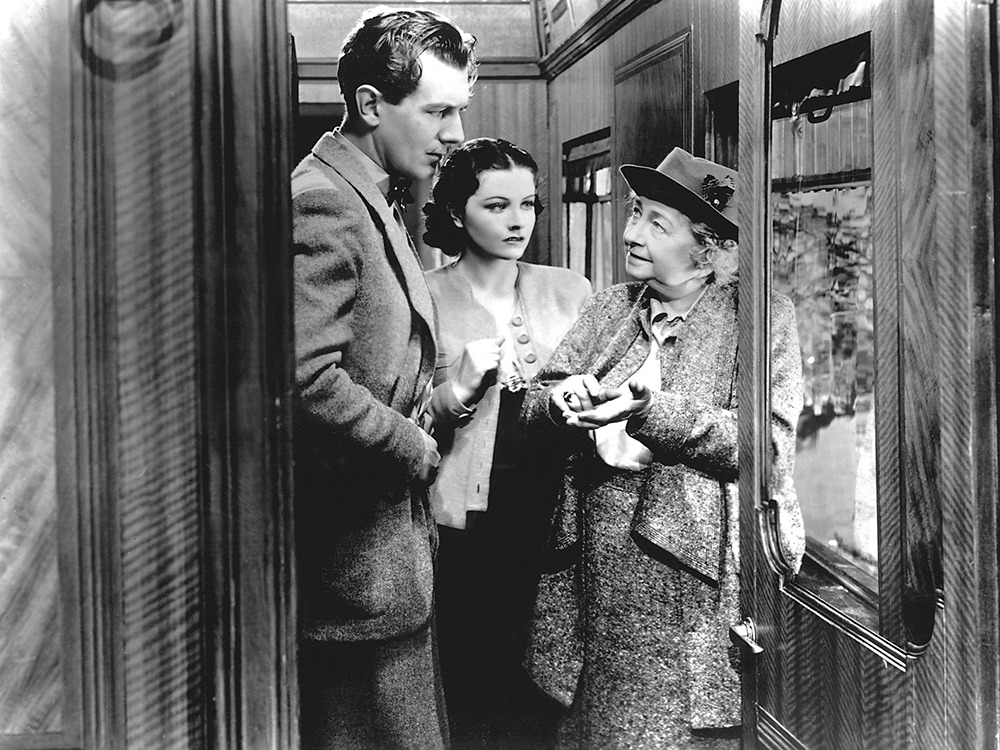
Iris, a British tourist in the Balkans, wakes up on the train to discover that dear old Miss Froy, with whom she had a chat before her nap, has disappeared without a trace. There is another woman sitting there, wearing Miss Froy's clothes. No one knows anything about the real Miss Froy. Before she realises it, Iris is in the middle of an espionage plot. But with the help of plucky musician Gilbert and the phlegmatic duo Caldicott and Charters, she will manage to bring the real Miss Froy, who is carrying top secret data, safely to England.
EN
“The film arose in a more accidental way than was customary with Hitchcock. In 1937, he was at a turning point in his career. After making his way to the forefront of the British film industry with works like The Man Who Knew Too Much (1934) and The 39 Steps (1935), he was involved in negotiations with David Selznick that would soon take him to Hollywood. Still under contract to Gaumont British, however, and at loose ends for a script, he reached for a project already developed and in fact nearly filmed a year earlier by the American director Roy William Neill. Though Hitchcock and his wife, Alma Reville, made significant adjustments (notably with regard to the early hotel scenes and the final shootout), the script (freely adapted from the novel The Wheel Spins, a rather unthrilling thriller by Ethel Lina White) is very much the work of the brilliant screenwriting team of Sidney Gilliat and Frank Launder, to whom especially can be credited the verbal richness of the comedy, whether it's Miss Froy busying herself with "a most intriguing acrostic in The Needlewoman" or Basil Radford's Charters expostulating, "After all, people don't go about tying up nuns!" [...].
The cozy claustrophobia of the film, as it moves from overcrowded hotel to tightly packed train compartment, reflects the circumstances of the budget-conscious British film industry of the time (constraints under which Hitchcock had honed his skills). It was shot, according to Hitchcock, "on a set ninety feet long. We used one coach; all the rest were transparencies or miniatures." A reassuring sense of smallness of scale is instilled by the opening panorama of a snowbound toy train station in the remote Balkan enclave of Bandrika, "one of Europe's few undiscovered corners"; Hitchcock might still be the little boy whose hobby was collecting train schedules from around the world. A hint of giddiness at the harmlessness of it all demonstrates from the start that we are in a world created by movies-the same world explored by Lubitsch comedies and Astaire and Rogers musicals-in which the worst things that can happen are the minor discomforts and embarrassments of travel.”
Geoffrey O'Brien1
“Miss Froy's music carries with it what Kristeva has termed "abjection," the threat of horror, silence, and death as visualized in the strangulation of the lone guitarist who first performs it. In contrast, Gilbert's rendition of the ancient folk music of Central Europe is in no way natural, expressive, or evocative: he forces the rather reluctant servants to engage in a dance routine that he alone orchestrates and manipulates. His intent in performing this music is articulated, moreover, as a desire to preserve and promote the "ancient" sexual/ social relations of patriarchal culture (the dance Gilbert orders up, he explains to the chateau manager, is " the dance they danced when your father married your mother"), and thus Gilbert is implicated in what Kristeva in Powers of Horror calls the desire "to know everything, to know, in particular, what seems to be lacking in his mother or could be lacking in himself" (p. 34). Explicitly represented as competing with the guitar serenade, Gilbert's music so annoys Iris that she reports Gilbert to the management. In retaliation, Gilbert forces himself into her room, tosses his cane onto her bed (only after he kisses it), and challenges her to get rid of him. As representative of the patriarchal order, Gilbert's music (not to mention his rather obnoxious behavior, noisily singing, brushing his teeth, and running the bathwater) sets up a strong polarity between himself and Miss Froy, respectively distinguishing and identifying the paternal and maternal registers of the film.”
Marshall Deutelbaum, Leland PoagueMarshall Deutelbaum, Leland Poague, A Hitchcock Reader, edited by Marshall Deutelbaum and Leland Poague (Hoboken: Wiley-Blackwell, 2009), 129.
- 1Geoffrey O'Brien, “The Lady Vanishes: All Aboard!,” Criterion Collection, 6 December 2011.

